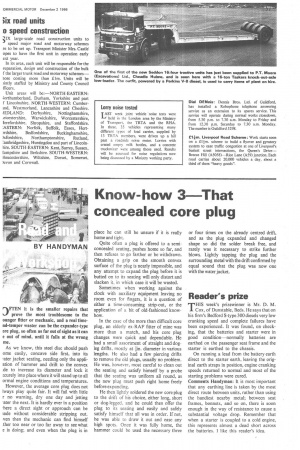Know-how 3—That concealed core plug
Page 79

If you've noticed an error in this article please click here to report it so we can fix it.
a FTEN it is the smaller repairs that
prove the most troublesome to the ounger fitter or mechanic, and a real timend-temper waster can be the expander-type are plug, so often as far out of sight as it can e out of mind, until it fails at the wrong me.
As we know, this steel disc should push ome easily, concave side first, into its 'ater jacket seating, needing only the appliation of hammer and drift to the convex de to increase its diameter and lock it !curely into place where it will stand up to all ormal engine conditions and temperatures. However, the average core plug does not lways play quite fair. It will fail with little r no warning, dry one day and jetting 'ater the next. It is hardly ever in a position 'here a direct sight or approach can be iade without considerable stripping out. yen then the mechanic can find himself ther too near or too far away to see what e is doing; and even when the plug is in
place he can still be unsure if it is really home and tight.
Quite often a plug is offered to a semiconcealed seating, pushes home so far, and then refuses to go farther or be withdrawn. Obtaining a grip on the smooth convex surface of the plug is nearly impossible, and any attempt to expand the plug before it is butted on to its seating will only distort and slacken it, in which case it will be wasted.
Sometimes when working against the clock with auxiliary equipment leaving no room even for fingers, it is a question of either a time-consuming strip-out, or the application of a bit of old-fashioned knowhow.
In the case of the more than difficult core plug, an elderly ex-RAF fitter of mine was more than a match, and his core plug changes were quick and dependable. He had a small assortment of straight and dogleg drifts, mostly at tin. diameter in various lengths. He also had a few piercing drifts to remove the old plugs, usually no problem. He was, however, most careful to clean out the seating and satisfy himself by a probe that the seating was uniform all round, as the new plug must push right home freely before expanding.
He then lightly soldered the new core plug to the drift of his choice, either long, short or dog-legged, and he could then offer the plug to its seating and easily and safely satisfy himself that all was in order. If not, he was able to draw it out and ease any high spots. Once it was fully home, the hammer could be used the necessary three or four times on the already centred drift, and as the plug expanded and changed shape so did the solder break free, and rarely was it necessary to strike further blows. Lightly tapping the plug and the surrounding metal with the drift confirmed by equal sound that the plug was now one with the water jacket.
Reader's prize
+THIS week's prizewinner is Mr. D. M.
Cox, of Dun stable, Beds. He says that on his firm's Bedford S-type 300 diesels very low cranking speed and complete failures have been experienced. It was found, on checking, that the batteries and starter were in good condition—normally batteries are earthed on the passenger seat frame and the starter is earthed to the chassis.
On running a lead from the battery earth direct to the starter earth, leaving the original earth straps in position, engine cranking speeds returned to normal and most of the starting problems were cured.
Comments Handyman: It is most important that any earthing line is taken by the most direct route between units, rather than using the handiest nearby metal; between seat frames, bonnets, and so on, there is soon enough in the way of resistance to cause a substantial voltage drop. Remember that when a starter is coupled to a cold engine, this represents almost a dead short across the batteries. I like this reader's idea.
































































































































































































